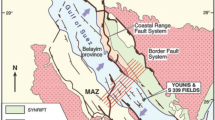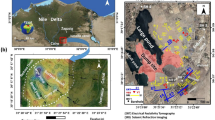Abstract
This paper discusses the geological and geotechnical potentialities of Ntem formations from the Memve’ele dam construction. Stratigraphic formations on the dam site consist from top to bottom sand, silty sand, silty, silty clay, very to moderate weathered rocks with a thickness of about 0.5–3 m above a sound bed rock which are represented by Ntem formations. These rocks have main mineral associations represented by orthopyroxene, clinopyroxene, quartz, plagioclase and garnet, display reaction textures, idiomorphic crystals, straight boundaries between crystals, the iron bearing amphibole, biotite and epidote, quartz ribbons and iron minerals (ilmenite and magnetite) are also present. All these permit to class them from granulite to amphibolite facies metamorphic conditions; therefore they are very hard and appear good for civil applications. The permeability has thickness from 0 to 13 m in the depth with Lugeon values higher than 15 UL. The RQD values are permitted to class these rocks as being moderated to good resistant. These character features which improve their geophysical properties (e.i. hard quality) have permitted that the dam and powerhouse foundations refitting on them. According to geophysical properties and rock mass rating, the rock mass is fair and good and is classified to class II and III. All these indicate that the rock mass is well compacted and sound with sparsely spaced discontinuities. The Ntem formations have uniaxial compressive strength under saturated condition generally higher than 40 Mpa, dry density or specific weight not less than 2.7 g/cm3, low porosity (average from 0.69 to 0.83%), low coefficient of water absorption (average from 0.012 to 0.04%), deformation modulus from 82.3 to 87.86 Gpa, Los Angeles and Micro Deval values are lower than 40% and 20% respectively, swelling risks are very limited with low values (1.07–1.11%) of sulphate, under 4.5% of cement and low values (0–0.07%) obtained during alkali-reaction test. All these have permitted that to obtain concrete aggregate and rip rap by crushing and processing these rocks from quarry during the dam, spillway, powerhouse and road constructions. These results confirm use of these formations during Memve’ele dam constructions.









Similar content being viewed by others
References
AFNOR NF EN 1097-2 (2010) Essais pour déterminer les caractéristiques mécaniques des granulats—Partie 2: méthode pour la détermination de la résistance à la fragmentation. p 32
AFNOR NF EN 1744-1 (2014) Essais visant à déterminer les propriétés chimiques des granulats—Partie 1: analyse chimique. p 4
AFNOR NF P94-054 (1991) Sols, reconnaissance et essais-Détermination de la masse volumique des particules solides des matériaux-Méthode du pycnomètre à eau. p 17
AFNOR NF P94-064 (1993) Sols, reconnaissance et essais-Masse volumique sèche d’un élément de roche-Méthode par pesée hydrostatique. p 6
AFNOR NF P94-050 (1995) Sols, reconnaissance et essais-Détermination de la teneur en eau pondérale des matériaux-Méthode par étuvage. p 12
AFNOR NF P94-420 (2000) Roches-Détermination de la résistance à la compression uniaxiale. p 7
AFNOR NF P18-572 (2005) Essais pour déterminer les caractéristiques mécaniques des granulats—Partie 2: Méthode pour la détermination de la résistance à l’usure. p 30
AFNOR NF EN 933-1 (2012) Essais pour déterminer les caractéristiques géométriques des granulats—Partie 1: détermination de la granulite-Analyse granulométrique par tamisage. p 12
AFNOR NF P18-594 (2015) Granulats—Méthode d’essais de réactivité aux alcalis. p 6
AFNOR NF P18-594 (2015) Granulats—Reconnaissance et essais-Essais d’eau Lugeon. p 11
AFTS-ISRM (1981) Suggested methods for the quantitative description of discontinuities in rock masses. In: Rock characterization, testing and monitoring. Pergamon oxford
Barton N (1995) The influence of joint properties in modelling jointed rock masses. In: Japan T, Fujii A, Balkema A (eds) Proceedings of the ISRM 11th international congress on rock mechanics. Rotterdam, Tokyopp, pp 1023–1032
Bessoles B, et Trompette R, (1980) Géologie de l’Afrique : la chaîne panafricaine « zone mobile d’Afrique centrale (partie sud) et zone mobile soudanaise » . Mémoires du BRGM, 92
Bieniawski ZT (1989) Engineering rock mass classifications. Wiley, New York
Boniface N, Schenk V, Appel P (2012) Paleoproterozoic eclogites of MORB-type chemistry and three. Proterozoic orogenic cycles in the Ubendian Belt (Tanzania): evidence from monazite and zircon geochronology, and geochemistry. Precambr Res 192–195:16–33
Bouchez J-L, Delas C, Gleizes G, Nedelec A, Cuney M (1992) Sub-magmatic micro-fractures in granites. Geology 20:35–38
Deere DU, Deere DW (1987) The rock quality designation (RQD). Index in practice, 8
GB50487 (2008). Code for engineering geological investigation of water resources and hydropower
Hamid S, Mohammad G, Gholamreza L (2015) Evaluation of grout curtain performance and Doosti dam, Iran. Indian J Nat Sci 6:8539–8551
Hao-Feng Xing X-N, Gong XG, Zhou H, Fu F (2006) Construction of concrete-faced rockfill dams with weak rocks. J Geotech Geoenviron Eng 132(6):1090–10241
Iliev IG (1966) An attempt to estimate the degree of weathering of intrusive rocks from their physico-mechanical properties. In: Proceedings of 1st congress ISRM. Lisbon, V1 P109
Leulalem SB, Kifle W, Nata T (2016) Geological and geotechnical investigations of Axum dam site, Tigray, Northern Ethiopia. Int J Sci Technol Res 5:111p
Maurizot PA, Feybesse JL, Johan et Lecomte P (1986) Etude et prospection minière du Sud-Ouest Cameroun, Synthèse s travaux de 1978à 1985. Rapp. BRGM, 85, CMR066, p 274
Mvondo Owona S, Ondoa J, Mbola Ratschbacher L, Ndzana SP, Tchoua MF, Ekodeck GE (2011) The geometry of the Archean, Paleo- and Neoproterozoic tectonics in the Southwest Cameroon. Comptes Rendus Geosci 343:312–322
Ntomba SM, Ndong BF, Messi OJE, Goussi NFJ, Bisso D, Magnekou TCR, Mvondo OJ (2016) Phlogopite compositions as indicator of both the geodynamic context of granitoids and the metallogeny aspect in Memve’ele Archean area, north western Congo Craton. J Afr Earth Sci 118:231–244
Pouclet A, Tchameni R, Mezger K, Vidal M, Nsifa EN, Shang CK, Penaye J (2007) Archaean crustal accretion at the northern border of the Congo craton (South Cameroon); the charnockite-TTG link. Bull Soc Géol France 178:331–342
Shang CK (2001) Geology, geochemistry and geochronology of archean rocks from the Sangmelima Region, Ntem Complex NW Congo Craton, South Cameroon. PhD Thesis, University of Tübingen, Germany
Shang CK, Satir M, Siebel W, Nsifa EN, Taubald H, Liégeois JP, Tchoua FM (2004a) Major and trace element geochemistry, Rb-Sr and Sm-Nd systematics of TTG magmatism in the Congo craton: case of the Sangmelima region, Ntem complex, southern Cameroon. J Afr Earth Sci 40:61–79
Shang CK, Siebel W, Satir M, Chen F, Mvondo JO (2004b) Zircon Pb-Pb and U-Pb systematics of TTG rocks in the congo craton: constraints of crustal formation, crystallization and Pan-African lead loss. Bull Geosci 79:205–219
Sierra JM, Ramirez CA, Hacelas JE (1985) Design features of Salvajina dam. In: Cooke JB, Sherard JI (eds) Proceedings concrete face rockfill dams-design, Construction and Performance, pp 266–285
Smith MR, Collis L (2001) Aggregates-sand, gravels and crushed rock aggregates for construction purposes, 3rd edn. The geological society of London, London, pp 199–224
TallaTakam MA, Kokonyangi J, Dunkley DJ, Nsifa EN (2009) Paleoarchean charnockite in the Ntem Complex, Congo Craton, Cameroon: Insights from SHRIMP zircon U-Pb ages. J Mineral Petrol Sci 104:1–11
Tchameni R, Mezger K, Nsifa EN, Pouclet A (2000) Neoarchean evolution in the Congo craton: evidence from. K-rich granitoids of the Ntem complex, Southern Cameroun. J Afr Earth Sci 30:133–147
Tchameni R, Mezger K, Nsifa EN, Pouclet A (2001) Crustal origin of early proterozoic syenites in the congo craton (Ntem Complex), South Cameroon. Lithos 57:23–42
Tchameni R, Pouclet A, Mezger K, Nsifa EN, Vicat JP (2004) Monozircon and Sm-Nd whole rock ages from the Ebolowa greenstone belts; evidence for the terranes older than 29 Ga in the Ntem complex (Congo Craton, South Cameroon). J Cameroon Acad Sci 4(3):213–224
Tchameni R, Lerouge C, Penaye J, Cocherie A, Milesi JP, Toteu SF, Nsifa NE (2010) Mineralogical constraint for metamorphic conditions in a shear zone affecting the Archean Ngoulemakongtonalite, Congo Craton (Southern Cameroon) and retentivity of U-Pb SHRIMP zircon dates. J Afr Earth Sci 58:67–80
Toteu SF, Van Schmus WR, Penaye J, Nyobe JB (1994) U-Pb and Sm–Nd evidence for Eburnean and Pan-African high grade metamorphism in cratonic rocks of Southern Cameroon. Precambr Res 67:321–347
Yavuz F, Gültekin AH, Örgün Y (2002) Mineral chemistry of barium- and titanium-bearing biotites in calc-alkaline volcanic rocks from the Mezitler area (Balιkesir-Dursunbey), Western Turkey. Geochem J 36:563–580
Acknowledgements
The authors express their sincere acknowledges to the Head staff of Memve’ele hydroelectric dam project and to the Sinohydro Corporation Limited for access both to the site and the data of the dam. We are grateful to anonymous reviewers for their suggestion to improve the manuscript.
Author information
Authors and Affiliations
Corresponding author
Additional information
Publisher's Note
Springer Nature remains neutral with regard to jurisdictional claims in published maps and institutional affiliations.
Rights and permissions
About this article
Cite this article
Bisso, D., Ntomba, S.M., Mengbwa, R.C. et al. Geological and Geotechnical Characteristics of Ntem Formations: Insight of its Applications in the Memve’ele Dam Construction (Southern Cameroon). Geotech Geol Eng 38, 4585–4601 (2020). https://doi.org/10.1007/s10706-020-01312-7
Received:
Accepted:
Published:
Issue Date:
DOI: https://doi.org/10.1007/s10706-020-01312-7




